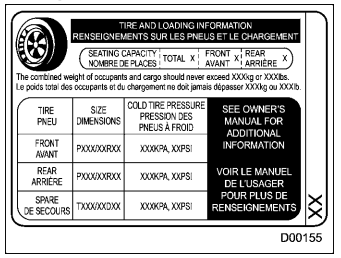Subaru Forester: Tire information / Recommended tire inflation pressure
Recommended cold tire inflation pressure
For recommended cold tire inflation pressure for your vehicle’s tires, refer to “Tires”.
Vehicle placard

The vehicle placard is attached to the driver’s side door pillar.
Example:

The vehicle placard shows original tire size, recommended cold tire inflation pressure on each tire at maximum loaded vehicle weight, seating capacity and loading information.
Adverse safety consequences of under-inflation
Driving at high speeds with excessively low tire pressures can cause the tires to flex severely and to rapidly become hot. A sharp increase in temperature could cause tread separation, and failure of the tire(s). Possible resulting loss of vehicle control could lead to an accident.
Measuring and adjusting air pressure to achieve proper inflation
Check and, if necessary, adjust the pressure of each tire (including the spare) at least once a month and before any long journey. Check the tire pressures when the tires are cold. Use a pressure gauge to adjust the tire pressures to the specific values. Driving even a short distance warms up the tires and increases the tire pressures. Also, the tire pressures are affected by the outside temperature. It is best to check tire pressure outdoors before driving the vehicle. When a tire becomes warm, the air inside it expands, causing the tire pressure to increase. Be careful not to mistakenly release air from a warm tire to reduce its pressure.
 Tire labeling
Tire labeling
M..
 Glossary of tire terminology
Glossary of tire terminology
Accessory weight
The combined weight (in excess of
those standard items which may be
replaced) of automatic transmission,
power steering, power brakes,
power windows, power seats, radio,
and heater, to the extent that these
items are available as factory-installed
equipment (whether instal..
Other information:
Subaru Forester 2019-2026 Owners Manual: Components
SRS frontal airbag SRS side airbag SRS curtain airbag SRS knee airbag The SRS airbags are stowed in the following locations. Driver’s SRS frontal airbag: in the center portion of the steering wheel A “SRS AIRBAG” mark is located at the pad of the airbag...
Subaru Forester 2019-2026 Owners Manual: Remote control mirror switch
: Select side to adjust : Direction control The remote control mirrors operate only when the ignition switch is in the “ON” or “ACC” position. Turn the control switch to the side that you want to adjust. “L” is for the left mirror, “R” is for the right mirror...
Categories
- Manuals Home
- Subaru Forester Owners Manual
- Subaru Forester Service Manual
- Unlock using PIN Code Access
- Shift lock release using the shift lock release button
- To activate/deactivate the X-MODE
- New on site
- Most important about car
Windshield wiper and washer switches
The wiper operates only when the ignition switch is in the “ON” or “ACC” position.
